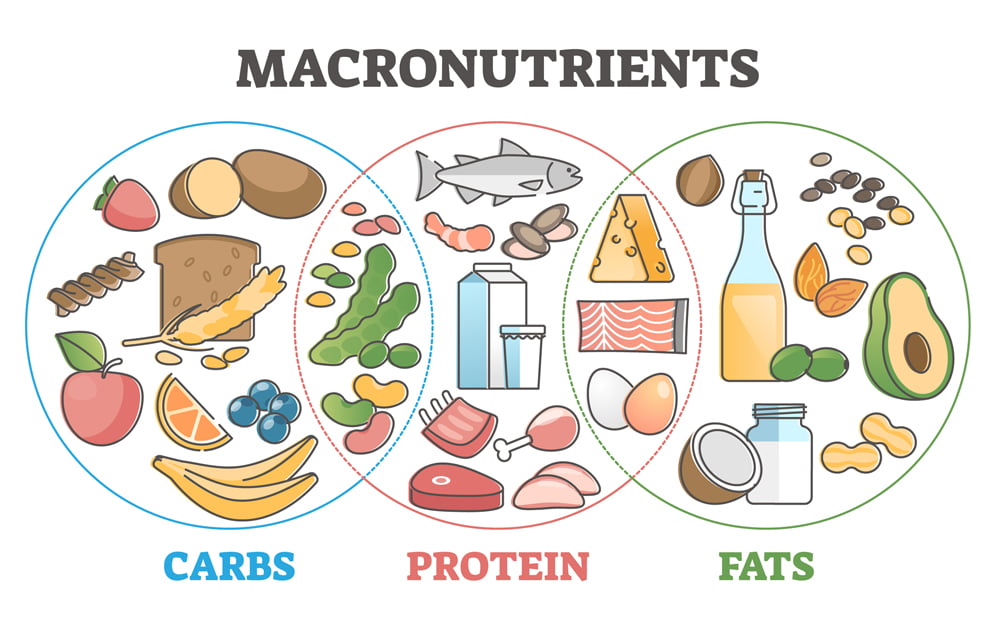Table of Contents
Forget the diet drama and confusing jargon. Let’s crack the code of your body’s fuel, the big three macronutrients: carbs, proteins, and fats. Imagine them as the bricks, beams, and insulation of your magnificent mansion.
“Macronutrients are the fundamental building blocks of our health and performance. Understanding their roles and optimizing your intake can be transformative, unlocking a whole new level of well-being.” – Dr. Lisa Young, PhD, RDN
- Carbs: the instant energy bricks, keeping your lights on and workouts crushing.
- Proteins: the steel beams, build and repair your muscles and tissues.
- Fats: the cozy insulation, keeps you warm, and satiated, and your brain firing on all cylinders.
But here’s the twist: not all macronutrients are created equal. There are good guys and not-so-good guys in each category, and knowing the difference is key to unlocking your ultimate health potential.
So, buckle up, because we’re about to demystify each macronutrient, bust some myths, and equip you with actionable tips to build a vibrant you, inside and out.

Introduction to Macronutrients
Power Play: Understanding Carbs and Why They’re Not the Enemy
Carbs get a bad rap, but they’re actually your body’s preferred fuel source, especially for that morning run you’re conquering! The key is choosing complex carbs like whole grains, sweet potatoes, and fruits.
These guys release energy slowly and steadily, keeping you fueled and focused throughout the day. No more sugar crashes or midday slumps!
But wait, there’s more! Ever heard of the glycemic index (GI)? It ranks carbs based on how fast they raise your blood sugar. High-GI carbs like white bread and sugary treats send your blood sugar on a rollercoaster, leaving you feeling drained and craving more.
Low-GI carbs like oats and legumes, however, are the steady Eddie’s of the carb world, keeping your blood sugar stable and energy levels consistent.
Want to become a GI master? I’ll share a handy chart and practical tips for choosing low-GI carbs in the FAQ section. Stay tuned!
Building Blocks of Brilliance: Protein’s Powerplay for Peak Performance
Next up, the mighty protein! Think of it as the magic potion for building and repairing muscles, bones, and even your gorgeous hair and skin. It keeps you feeling full and satisfied, making it your BFF for conquering those hunger pangs.
But hold on, before you chug a protein shake every hour, hear this: too much protein can be a party pooper, stressing your kidneys and slowing down digestion.
Speaking of party poopers, don’t worry, vegan and plant-based warriors! We’ll explore all the amazing protein sources you can rock without animal products. Stay tuned!
Busting Myths and Embracing Their Benefits

And now, the grand finale: fats! Yep, you read that right. Contrary to popular belief, healthy fats are your body’s BFFs (Balance for Fuel & Fitness). They keep you energized, lubricate your joints, and even boost your brainpower.
Ditch the fear of the dreaded “F” word and embrace the goodness of avocados, nuts, and fatty fish. These guys are packed with essential nutrients like Omega-3s, the champions of heart health and cognitive function.
But beware, not all fats are created equal. We’ll uncover the sneaky villains hiding in processed foods and learn how to make smart fat choices to craft a body and mind that shines. Stay tuned!
Combining Macronutrients for Optimal Health
Macronutrient Mateship: Combining for Conquering Your Goals
Now that you know the superstars of each team, let’s talk about creating a winning team together. Your ideal macronutrient balance depends on your goals, whether it’s weight loss, muscle gain, or simply optimizing your health.
For example, someone trying to build muscle might focus on a slightly higher protein intake, while someone aiming for weight loss might prioritize complex carbs and healthy fats.
Want to know how to calculate your own personalized macronutrient needs? No sweat, we’ll explore helpful tools and resources in the FAQ section. Stay tuned!
Macronutrient Magic: Sample Meal Plans and Beyond
Ready to put your newfound knowledge into action? I’ve got you covered with some delicious and satisfying sample meal plans that incorporate all three macronutrients in a balanced way.
We’ll show you how to whip up breakfast bowls with complex carbs and healthy fats, protein-packed salads for lunch, and dinners that are both flavorful and nutritious.
But it doesn’t stop there! We’ll also explore advanced strategies like macronutrient cycling for experienced individuals who want to take their nutrition to the next level. Stay tuned!
Macronutrient Mythbusters: Dispelling the Diet Drama
Diet culture loves bombarding us with confusing and often misleading information about carbs, protein, and fats. Let’s shed light on some of the biggest myths to ensure your journey to nutritional awareness is based on truth:
- Myth: All carbs are bad and make you fat.
- Fact: Complex carbs like whole grains, fruits, and vegetables provide essential fiber and sustained energy, while refined carbs often lead to blood sugar spikes and crashes.
- Myth: You need tons of protein to build muscle.
- Fact: While protein is crucial for muscle growth, the amount you need depends on your individual factors like body size and activity level. Consuming too much protein can place a burden on your kidneys.
- Myth: All fats are bad and should be avoided.
- Fact: Healthy fats like avocado, nuts, and fatty fish are essential for heart health, brain function, and satiety. Processed and unhealthy fats, however, can contribute to negative health outcomes.
“The demonization of certain macronutrients like carbs is unfounded and potentially harmful. Embracing a balanced approach is key. Choose complex carbs like whole grains over refined options, and don’t shy away from healthy fats, which play vital roles in brain function and heart health.” – Dr. David Ludwig, MD, PhD
Practical Tips for Using Macronutrients
Macronutrient Matchmakers: Your Shopping List Essentials

Knowing the good guys and not-so-good guys from each macronutrient category is key to making informed choices at the grocery store. Here’s a quick cheat sheet to guide your shopping adventures:
Carbs:
- Go for: Whole grains (brown rice, quinoa, oats), fruits (berries, apples, pears), vegetables (sweet potatoes, carrots, broccoli)
- Limit: White bread, refined pasta, sugary cereals, pastries
Proteins:
- Go for: Lean meats (chicken, fish, turkey), eggs, beans and lentils, tofu and tempeh, Greek yogurt
- Limit: Processed meats (sausages, hot dogs), fatty cuts of meat, fried foods
Fats:
- Go for: Avocados, nuts and seeds, olive oil, fatty fish (salmon, tuna, mackerel)
- Limit: Processed foods high in saturated and trans fats, deep-fried foods, butter-laden pastries
Macronutrient Mateship in Action: Sample Meal Plans for Every Goal
Ready to see how these macronutrient superstars come together in real life? Here are some sample meal plans tailored to different goals:
Weight Loss:
- Breakfast: Greek yogurt with berries and almonds
- Lunch: Salad with grilled chicken, quinoa, and vegetables
- Dinner: Baked salmon with brown rice and roasted vegetables
Muscle Gain:
- Breakfast: Protein smoothie with oatmeal, banana, and spinach
- Lunch: Tuna salad sandwich on whole-wheat bread with avocado
- Dinner: Chicken stir-fry with brown rice and broccoli
Optimal Health:
- Breakfast: Scrambled eggs with avocado and whole-wheat toast
- Lunch: Lentil soup with whole-grain bread and side salad
- Dinner: Baked tofu with roasted Brussels sprouts and sweet potato wedges
Advanced Strategies and Resources
Macronutrient Mastery: Tools and Resources for Advanced Players
If you’re ready to take your nutrition game to the next level, check out these advanced strategies and resources:
- Macronutrient calculators: These tools help you determine your personalized macronutrient needs based on your age, weight, activity level, and goals.
- Meal planning apps: These apps make it easy to plan and track your meals, ensuring you’re hitting your macronutrient targets.
- Healthy recipe websites: Explore a plethora of delicious and nutritious recipes that fit your specific dietary needs and preferences.
- Nutrition books and blogs: Stay updated on the latest research and practical tips from qualified nutrition professionals.
Remember, your journey to macronutrient mastery is a continuous process of learning, exploration, and experimentation. Don’t be afraid to get creative, seek inspiration from others, and adjust your approach as needed.
Your body is your own personal biochemist, and you’re the master chef in charge of fueling it for optimal health, performance, and well-being. So, grab your spatula, embrace the power of macronutrients, and start building the thriving body and brilliant mind you deserve!
Check the Macronutrient Frequently Asked Questions below.
Macronutrient Mastermind: Demystifying Your FAQs
So, you’ve cracked the code of carbs, proteins, and fats, but still have some lingering questions? Don’t sweat it! This FAQ section is your go-to guide for all things macronutrients, from practical tips to busting common myths.
How do I calculate my individual macronutrient needs?
No magic formula here, but some handy online tools can help! Check out sites like IIFYM.com or the MyFitnessPal macronutrient calculator. They’ll consider your body stats, activity level, and goals to give you a personalized target range for carbs, protein, and fat. Remember, these are just guidelines, and fine-tuning may be needed based on your individual response.
I love pasta! Does that mean I can’t reach my fitness goals?
Hold your horses, carb-lover! Not all carbs are created equal. Ditch the refined pasta and embrace whole-wheat options like brown rice, quinoa, and buckwheat. These complex carbs release energy slower, keeping you feeling full and focused. Remember, portion control is key too! A smaller serving of whole-wheat pasta paired with protein and veggies can be a perfectly balanced meal.
Are plant-based eaters destined for protein deficiency?
Absolutely not! Plants are bursting with protein powerhouses. Think beans and lentils, chickpeas, tofu and tempeh, nuts and seeds, quinoa, and even leafy greens like spinach. Combining these protein sources throughout the day ensures you’re getting all the essential amino acids. Feeling overwhelmed? Check out cookbooks or websites dedicated to delicious plant-based protein recipes.
I heard coconut oil is the “healthy fat” king. Is that true?
Hold on, buttercup! While coconut oil has some benefits, it’s also high in saturated fat. Moderation is key. Opt for a variety of healthy fats like avocado, nuts and seeds, olive oil, and fatty fish. They provide crucial omega-3s and keep your brain and heart happy and healthy! Remember, even “healthy” fats are calorie-dense, so track your intake to avoid unwanted surprises on the scale.
Is macronutrient cycling magic or madness?
Depends on your goals and experience level! For beginners, stick to consistent macronutrient intake until you understand your body’s needs. However, experienced athletes and individuals seeking faster progress may benefit from cycling their macronutrients (e.g., higher carbs on training days, higher protein on rest days). It’s more advanced and requires careful planning, so do your research and seek guidance from a qualified nutritionist before diving in.
#Macronutrients #Proteins #Carbohydrates #Fats #NutritionFacts #HealthyEating #DietaryIntake #BalancedDiet #NutrientRich #FuelYourBody
Was this Article Helpful?
We hope that you found this article helpful and informative. We are always striving to provide you with the best content and resources about macronutrients. We would love to hear from you and get your feedback and suggestions.
Please visit our Facebook page and leave us a comment or a message. Tell us what you liked or disliked about this article, what you learned or want to learn more about, and what you want us to write about next.
Your input is very valuable to us and helps us improve our work and achieve our goal of helping you reach your health and fitness goals. Thank you for reading and supporting us.





















